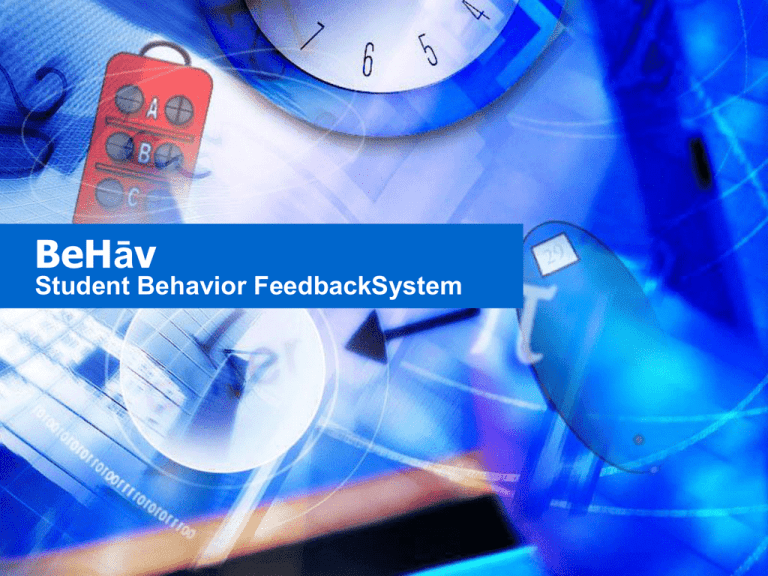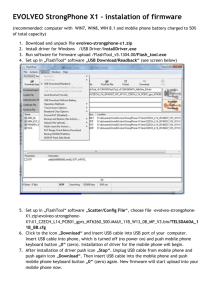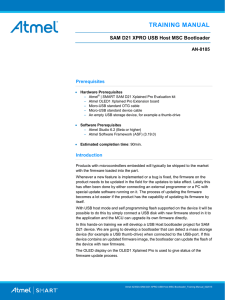(1.84 MB PowerPoint)
advertisement

BeHāv Student Behavior FeedbackSystem Overview • • • • • • • • Team BeHāV Overview Schematic Parts Software Hub Timeline Budget Team Members • • • • • • Matthew Fargano Joshua Fedders Terrell Jones Nicholas Miller Mohamed Siddig Joseph Esler* *Software Systems Development Member What is BeHāv? • A Wireless System for Modifying Learning Disabled Students Behavior • A System for Tracking the Progress of Learning Disabled Students Features • • • • Wireless Small Size Long Battery Life Easy to Use Interface Schematic Schematic- USB & Transceiver Schematic- Real Time Clock Key Fob Originally we were considering using pre-programmable key fobs. However, this approach was unwarranted since we would have to reverse engineer the key fobs in order to make our transceiver on the other end communicate with it. Due to the synergy of the project, the key fob transmitter is similar in communication function compared to the receiver. This allows us to produce a transmitter almost directly from our receiver schematic. The major differences are: •Key fob uses 2 buttons •No Buzzer or Display Microcontroller- MSP430F2272 • • • • Processes incoming events. Applies timestamp Stores data Outputs data to external PC MSP430F2272 Advantages • Large Flash Memory – 32kB of Flash Memory • Low Power Consumption • UART, SPI, and I2C compatible interfaces • Flash Memory Program Execution Transceiver- MiRF v2 •Low cost •Low Power (Requires Switch Converter works with 3.3-7 V input) •Works with in our required area (30ft Radius) •125 Channels (Between 2.4MHz – 2.525 MHz) •Works in Open band (2.4GHz range) •Built in Antenna •Compact size •Readily available •Standby mode to save power Transceiver- Dev Board •Look at data sent and received over the wireless link. •Can tweak firmware on the MiRF v2 (change channel used) •Preloaded firmware for testing. •Low Cost Dev Board LED- Score Display •Lite-on LTD-2701 7-segment LED •Lower Power •7mm digit height •High Contrast •Wide Viewing Angle •Low Cost •Requires BCD BCD to 7-segment Driver • TI CD4511BE • CMOS • Latches input Vibrator- DC Motor G13566 •Costs less than $1 when bought in bulk •11 mm x 4.5 mm •Runs on as low as 1V DC (.05W) •Will require a MOSFET to power Power Regulator • • • • • • ADP2105 Buck Converter 2.7V - 5.5V input range 3.3V output ~96% Efficiency 1 A max load current Real Time Clock- MT41T0 Features: • Seconds, minutes, hours, day, date, month, years, and century • 32KHz crystal oscillator • Serial interface supports I2C bus • Low standby current 0.9μA (typ@3V) • 2.0 to 5.5V clock operating voltage Time Stamp Format Memory Capacity Flash Memory = 32kB Firmware = 10kB Event Logging Space = 22kB # of Bytes for a event = 555B ___________________________________ # of events that could be recorded = 4553 Or 10 Days of 1 event/min for 8 hours a day Software Architecture Spec. Sequence Diagram - Feedback To hub or not to hub? Hub Advantages • Single station for devices Hub Disadvantages • Limited mobility • Higher cost • Limited expansion Proposed USB Connect the Receiver directly to an external PC via USB. – Increased Mobility – Less Expensive – Supports any number of devices USB Port Interface Allows communication between our devices and the PC through Mini USB connection. This allows a easier form of programming and data retrieval than original base station design. This connector interfaces directly with the MSP430’s UART. This provides the option to incorporate a rechargeable battery by connection to the USB. •5 V input from USB bus (for rechargeable battery) •Variable baud rate •100mA maximum output current Project Costs Real Time Clock $20.00 7 segment LED $15.00 PCB $120.00 MSP430F2270 Sampled MSP430F2270 Dev Board Provided Transceiver+Dev board $100.00 USB Interface $40.00 Stripboard $11.00 G13566 Motor $3.00 Voltage Regulator $2.25 Documents $60.00 Other $28.75 Total $400.00 Receiver Unit Cost MSP430F2272 $3.00 $3.00 DC Vibrator $1.00 $1.00 Transceiver $28.00 $6.00 7-Segment LED $6.50 $2.00 Real Time Clock $5.00 $5.00 USB Interface $25.00 $7.00 PCB $40.00 $40.00 Voltage Regulator $2.25 $2.25 Total $110.75 $66.25 Milestone 1 • Wire wrap constructed system. • Able to receive input from external Key Fob source. • Timestamp and store events in internal flash. • Can retrieve data from system via USB connection. Milestone 2 • PCB board assembled, debugged, and working. • Displays score through 7-segment LED display. • Data interfaces with Microsoft Excel. Capstone Expo • Delivers a single unit working BeHāv system with following features. – – – – USB Interface Time stamped events 7-segment LED display of current score Vibrating receiver for feedback Schedule Tasks Mutual Tasks: Documentation, Tech manual, User manual Matt: Transceivers, MSP430 Firmware, and Proto-board lay out Josh: MSP430 Firmware, LED display, BCD Nick: Computer interface, USB, MSP430 Firmware, Real Time Clock Terrel: PCB, Transceivers, Proto-board lay out Mohamed: PCB, Real time clock, Transceivers, Proto-board lay out Questions?




